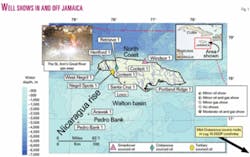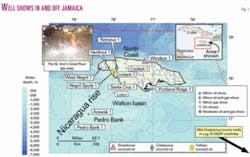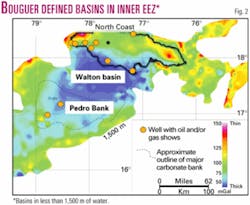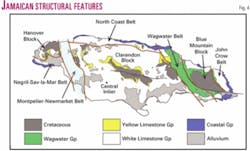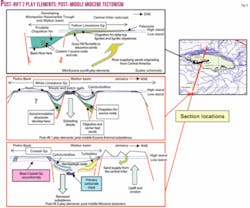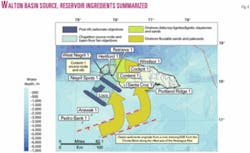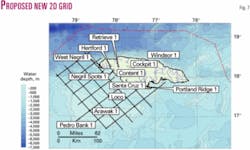A study by the Jebco Alliance for Petroleum Corp. of Jamaica finds that Jamaica has significant oil and gas potential with play settings akin to those in southern Sumatra and Northwest Java in western Indonesia.
The work relates to a Jamaican bid round that will open in 2005, when 22 offshore blocks will be on offer.
Exploration and data
Eleven wells were drilled in Jamaica between 1955 and 1982, ten of which yielded shows.1
These included the two offshore wells, Pedro Bank-1 (Occidental) and Arawak-1 (Union Texas and deepened by PCJ). In addition, there are onshore gas seeps, one of which is in daily use as a thermal source (Fig. 1). There are 16,126 km of offshore 2D seismic data, the most recent of which was acquired in 1983, and 641 km of onshore 2D seismic.
Biomarker analysis has identified three distinct oil families, none of which was previously known in the country. They are related to:
1. A mid-Eocene prodelta source.
2. A younger Cretaceous littoral source.
3. A Jurassic source that matches the Oxfordian Smackover source of the US Gulf of Mexico and Belize. Its discovery has required a major change to the model for the geological evolution of Jamaica.
When the oil family findings are combined with the results of extensive field work by the University of the West Indies,2 study of the just over 16,000 km of offshore seismic, and a major compilation of the gravity and magnetics, a wide range of opportunities emerges (Fig. 2). These plays are described following an introduction to the geology of Jamaica.
Geological evolution
The oldest rocks in the main body of the island comprise early to mid-Cretaceous (Valanginian to Albian) arc volcanics.
These were until recently thought to rest on oceanic crust, but large quartzite clasts in gravels at the base of the mid-Eocene transgressive sequence indicate that older continental affinity units must be present.
The overlying sequence, which is of end-Albian to early Campanian age, is formed of clastics and subordinate rudist limestones that accumulated in a deepening basin close to a volcanic arc. Source rocks in this unit of the quality to those recovered from the Leg 15 DSDP sites to the southeast of the island remain to be found, though there are candidate horizons.
Mid-Campanian southwards directed thrusting has recently been documented by Mitchell,2 and following the identification of the Smackover affinity oils in the North Coast Windsor-1 well this event is now attributed to an oblique collision with the southern Yucatan Block that resulted in the attachment to Jamaica of the North Coast Block.
The younger Cretaceous and probably also the Lower Palaeocene successions are dominated by shallow water to littoral clastics, rudist limestone, and some volcanics.
The Cretaceous aged oil, which was recovered from the Retreive-1 well, has geochemical affinities with the estuarine settings common within this islandwide unit. The Guinea Corn limestone reservoirs that were encountered in a number of onshore wells are of this age (Fig. 3).
Extension at a high angle to the earlier east-west grain of Jamaica and attributed to the initial opening of the Cayman Trough affected the island in the early Tertiary. It began in the east of the island (the John Crow Belt) in the basal Paleocene and spread westwards to create the deep Wagwater Belt in the mid-Paleocene and finally opened the Montpelier-Newmarket Trough in the east of the island in the mid-Eocene.
Ongoing research by UWI in the John Crow Mountains is revealing a package of potential source rocks and reservoir quality sandstones. Heavy oil was recovered from PCJ's Ecclesdown-1 corehole, but we were unable to extract oil from the single sample analyzed from this corehole.
Nevertheless, this region is looking increasingly attractive. The Wagwater Belt was subsequently severely tectonized and does not appear to be prospective. However, the gas seep at Annotto Bay on the North Coast is located above a gravity defined within this belt and may prove to be related to this trend (Fig. 4).
The Montpelier-Newmarket Trough is less severely deformed than the Wagwater Belt. The older infill succession forms part of the island wide Yellow Limestone Group and commences, using excellent outcrop control and the continuously cored Content-1 well, with the thick transgressive package of sands (Guys Hill formation), lignitic claystones, and limestones (Chapelton formation).
It is believed that the sands were supplied by a major river draining east-northeast along the axis of a then-elevated Nicaragua Rise from the Chortis Block of the Honduras region.
In the Content-1 well, the source package is thick, rich, and optimally mature immediately adjacent to the well site. Extracts from the well yielded oils whose biomarkers are fully compatible with the observed depositional environments. The biomarker oleanane, which when present in abundance is diagnostic of a Tertiary aged source, is present is the required amounts.
Rifting ceased in the late middle Eocene and a long period of carbonate accumulation began. The product is the White Limestone Group.
On Jamaica and the offshore banks settings varied from shelf environment to unstable deepwater regimes along the North Coast against the Cayman Trough. Deepwater settings persisted in lows within the Walton basin. Formerly this basin was thought to be occupied by the regional carbonate platform that capped the Nicaragua Rise at this time.
Tectonism was renewed towards the end of the middle Miocene. This event began with extension, but compression and uplift followed soon afterwards. Much of the island of Jamaica was emergent by the end of the Miocene. Offshore, the Nicaragua Rise carbonate platform was broken up into a series of banks and deep channels.
A strong pulse of tectonism affected the island in the last million years and resulted in the rapid uplift of the Blue Mountains. This event is attributed to the collision of the leading edge of the Nicaragua Rise on which Jamaica rides with Hispaniola.
The resulting plays
Thirteen play sectors occupy Jamaica and its inner EEZ.
Three of these because of their combination of geology and water depths offer immediate potential. These are the offshore Walton basin, the Pedro Bank, and the mainly onshore North Coast sector.
Most attractive because of their simpler geology are the Tertiary opportunities of the Walton basin and the Pedro Bank. The source is the mid-Eocene aged Chapelton formation.
Basin modeling controlled by vitrinite reflectance and the oil biomarker maturities from the Content-1 well indicate that the offshore kitchens are actively generating.
Basal synrift reservoirs are sands (Guys Hill formation) and limestones (for example the base of sequence Stettin formation) within the Yellow Limestone Group. Deep accommodation targets are expected in the synrift kitchens.
Post-rift objectives are patch reefs and shoals positioned above the synrift highs and possibly also Malampaya- or Luconia-type carbonate platforms. Top seal is provided by clayey hemipelagics within the Coastal and White Limestone groups.
Core and dredge results indicate that young calciturbidite reservoirs are present in the Walton basin. Outcrops also indicate that turbidites will be present along the northern margin of the Walton basin below the exit of rivers draining the pre-limestone sections, for example the Guys Hill formation sands.
Illustrated are the near vertical stacking of the play elements within the Walton basin depocenter. A risk is the breaching of traps by young faults, but these are localized and readily mapped. In addition, the cover above the young calciturbidites/turbidites may be too thin to act as a reliable sea (Figs. 5 and 6).
The play settings are analogous to the major fairways that dramatically emerged from the 1970s in the South Sumatra and Northwest Java basins. In relation to the South Sumatra basin, the comparisons are as follows:
In terms of Talang Akar and Baturaja reserves, in excess of 5,000 million bbl of oil and 12.5 tcf of gas3 have been discovered in these two basins, though a proportion of these reserves originates from pre-Talang Akar lacustrine sources.
There are also excellent similarities with the North Sumatra basin, though here a Talang Akar play remains to be found. The limestone reserves are greater than 1,000 million bbl of oil and greater than 15 tcf of gas.
The Cretaceous is not a primary objective, but its source rocks could contribute to the Tertiary plays and secondary objectives related to rudist limestones will emerge.
Fractured basement in the footwalls of fault zones defining the rift margins will also emerge. The latter could prove to be significant since more than 10 tcf of gas has been found, essentially by accident in the first discovery, in fractured basement below the rift footwalls of the South Sumatra basin. Similar plays exist elsewhere in Southeast Asia, for example Viet Nam.
The geology of the accreted North Coast Sector appears to be complex, and success in this area may not be easy to achieve. Field mapping in the Windsor-1 area hints that circular structures are present, and since the Smackover is commonly spatially associated with older evaporites these may prove to be present here, too. Evaporites provide the easiest explanation of why oil and gas have been preserved in the North Coast despite yo-yo tectonics of the region since the Miocene.
Success in the Walton basin, Pedro Bank, and North Coast Sectors will open up on trend opportunities elsewhere in the Jamaican Exclusive Economic Zone. Some of these, despite the increased water depths, are also expected to be significant.
Next steps
More than 1,900 km of deep record seismic on a 32 by 32 km grid are to be acquired for the offshore south and west of Jamaica, the objective being the verification of the play models ahead of more detailed 2D and, where required, 3D surveys (Fig. 7). Aeromagnetics, airborne gravity, and patented Seepfinder data will also be collected.
Acknowledgment
The Jebco Alliance consists of Jebco Seismic (UK) Ltd., plus GeoInsight Ltd., Gladestry Associates, and the Department of Geography and Geology, University of West Indies, Mona Campus, Kingston, Jamaica. F
References
1. Wright, R.M., "The Quest for Oil in Jamaica," in "Jamaica's Energy. 'Old Prospects New Resources,'" Petroleum Corp. of Jamaica, Chapter 2, 1996, pp. 22-35.
2. Mitchell, S.F., "Sedimentology and tectonic evolution of the Cretaceous rocks of central Jamaica: relationships to the plate tectonic evolution of the Caribbean," in Bartolini C., Burke, K., Buffler, R., Blickwede, J., and Burkart, B., eds., "Mexico and the Caribbean Region: Plate Tectonics, Basin Formation and Hydrocarbon Habitats," AAPG Memoir 79, 2004, pp. 605-623.
3. Howes, J.V.C., "Petroleum resources and Petroleum Systems of SE Asia, Australia, Papua New Guinea, and New Zealand," Indonesian Petroleum Association, Proceedings of the Petroleum Systems of SE Asia and Australia Conference, May 1997, pp. 81-100.
Bibliography
Rodrigues K., "Organic geochemistry and petroleum potential of Jamaica," Journal of Petroleum Geology, Vol. 14, No. 3, 1991, pp. 309-322.
The authors
Nick Cameron is managing director and owner of GeoInsight Ltd. His speciality has been the petroleum geology of West and East Africa, and he is now turning his attention increasingly to the Caribbean. Previously he worked for Conoco and the overseas division of the British Geological Survey. He holds a BA (hons.) from Keele University.
John Milsom is co-owner of Gladestry Associates, a geophysical and mapping consultancy based in the UK Welsh Borders. The company's specialty is regional geophysical evaluations using potential field records. Milsom is author of "Field Geophysics," a book republished last year.
Chris Matchette-Downes is director of new ventures and marketing at Jebco Seismic (UK) Ltd. His specialty is petroleum geoscience, and he has worked throughout Northwest Europe, the Far East, Australia, West and East Africa, and more recently the Caribbean. Previously he worked for Baker Hughes, Geochem Group, British Gas, PGS, and the BGS overseas division. He holds a BA (hons.) from Leicester University and an MSc from Newcastle University.
Simon Mitchell is a senior lecturer at the Department of Geography and Geology of the University of the West Indies at Kingston, Jamaica. For the last seven years he has systematically researched the geology of Jamaica, and a major paper on the island has just been published in the new AAPG Memoir on the Caribbean. Others are in press.
Raymond Wright is group managing director of Petroleum Corp. of Jamaica. He is and has been responsible for all national and international energy related matters, including renewable energy sources for Jamaica. He has degrees from Newcastle University and Stamford.
John E. Zumberge was manager of geological research for Occidental Petroleum Corp. and vice president of Ruska Laboratories. He is presently vice president and co-founder of GeoMark Research Ltd., a petroleum geochemical and fluids laboratory. He has a BS in chemistry from the University of Michigan and a PhD from the University of Arizona in organic geochemistry.
